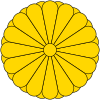Culture of Japan
This article needs additional citations for verification. (November 2015) |
| Part of a series on the |
| Culture of Japan |
|---|
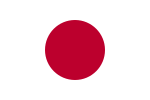 |
| History |
| People |
| Languages |
| Cuisine |
| Festivals |
|
The culture of Japan has changed greatly over the millennia, from the country's prehistoric Jōmon Period, to its contemporary modern culture, which absorbs influences from Asia and other regions of the world.[1]
Historical overview[]
Japan's indigenous culture originates primarily from the Yayoi people who settled in Japan between 1000 BCE and 300 CE. Yayoi culture spread to the main island of Honshū, mixing with the native Jōmon culture.[2] Modern Japanese have an estimated 80% Yayoi and 20% Jōmon ancestry.[3]
Japanese culture was influenced from ancient times to the Middle Ages primarily by multiple Chinese dynasties and to a lesser extent by other Asian countries. For example, one of the scripts for writing in the Japanese language is Chinese characters (kanji), but Japanese has no genetic relationship with Chinese.[4] Since the Meiji period Japan has been primarily influenced by western countries.
The inhabitants of Japan experienced a long period of relative isolation from the outside world for over 220 years during the Tokugawa shogunate until the arrival of the "Black Ships" and the Meiji period. Today, the culture of Japan stands as one of the most influential cultures around the world, mainly because of the global reach of its popular culture.[5][6] In 2020, U.S. News & World Report ranked Japan's cultural influence as the highest in Asia.[7]
Language[]
Japanese is the national and primary language of Japan. Japanese has a lexically distinct pitch-accent system. Early Japanese is known largely on the basis of its state in the 8th century, when the three major works of Old Japanese were compiled. The earliest attestation of the Japanese language is in a Chinese document from 256 AD. The Japanese language has no genetic relationship with Chinese,[4] belonging instead to a completely different family of languages known as the Japonic languages.
Japanese is written with a combination of three scripts: kanji, hiragana and katakana. Chinese characters, or kanji (漢字), are extensively used in Japanese writing as non-phonetic ideograms, imported from China to Japan in 50 AD; before that time, Japan had no system of writing. In the present day, there are a notable number[clarification needed] of kanji in modern Japanese with a different meaning from the corresponding hanzi character used in modern Chinese. Modern Japanese also features far fewer simplified Chinese characters in comparison to modern Chinese; Japanese people typically use fewer kanji in general and use them mainly for nouns, adjective stems and verb stems.
Both hiragana and katakana are phonetic syllabaries derived from the Chinese man'yōgana of the 5th century.[8] Hiragana and katakana were developed from simplified kanji; hiragana emerged somewhere around the 9th century[9] and was mainly used by women for informal language, with katakana mainly used by men for formal language. By the 10th century, both were commonly used by everyone.[10]
The Latin alphabet is often used in modern Japanese, especially for company names and logos, advertising, and when inputting Japanese into a computer. The Hindu-Arabic numerals are generally used for numbers, but traditional Sino-Japanese numerals are common.
Religion[]

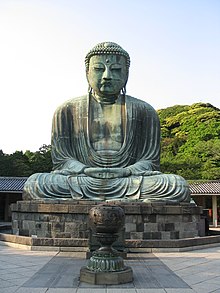
Shinto and Buddhism are the primary religions of Japan. According to the annual statistical research on religion in 2018 by the Government of Japan's Agency for Culture Affairs, 66.7 percent of the population practices Buddhism, 69.0 percent practices Shintoism, 7.7 percent other religions.[11] Minority Christian and Islamic communities exist. According to the annual statistical research on religion in 2018 by the Agency for Culture Affairs, Government of Japan, about two million or slightly 1.5% of Japan's population are Christians.[11] Muslims (70,000) are made up of largely immigrant communities, as well as, though much smaller, the ethnic Japanese community.[12]
Shinto[]
Shinto is an ethnic religion focusing on ceremonies and rituals. In Shinto, followers believe that kami – Shinto deities or spirits – are present throughout nature, including rocks, trees, and mountains. Humans can also be considered to possess a kami. One of the goals of Shinto is to maintain a connection between humans, nature, and kami. The religion developed in Japan prior to the 6th century CE, after which point followers built shrines to worship kami.[13]
Buddhism[]
Buddhism developed in India around the 6th and 4th centuries BCE and eventually spread through China and Korea. It arrived in Japan during the 6th century CE, where it was initially unpopular. Most Japanese people were unable to understand the difficult philosophical messages present in Buddhism; however, an appreciation for the religion's art is believed to have led to Buddhism later growing in popularity.[citation needed]
Buddhism is concerned with the cycle of rebirth and karma. In Buddhism, a person's status in society is considered unimportant, instead his good or bad deeds are valued, as every person eventually becomes ill, ages, dies, and is eventually reincarnated into a new life, a cycle known as saṃsāra; the suffering people experience during life is considered to be one way for people to ensure a better future, with the ultimate goal of Buddhism being to escape the cycle of death and rebirth by attaining true insight.[13]
National character[]

The Japanese "national character" has been written about under the term Nihonjinron, literally meaning "theories/discussions about the Japanese people" and referring to texts on matters that are normally the concerns of sociology, psychology, history, linguistics, and philosophy, but emphasizing the authors' assumptions or perceptions of Japanese exceptionalism; these are predominantly written in Japan by Japanese people,[14] though noted examples have also been written by foreign residents, journalists and even scholars.
Literature[]

Early works of Japanese literature were heavily influenced by cultural contact with China and Chinese literature, often written in Classical Chinese. Eventually, Japanese literature developed into a separate style in its own right as Japanese writers began writing their own works about Japan. The Tale of Genji, written by Murasaki Shikibu during the Heian period, is known worldwide as a unique Japanese literature. Since Japan reopened its ports to Western trading and diplomacy in the 19th century, Western and Eastern literature have strongly affected each other and continue to do so.
Visual arts[]

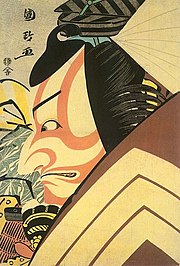
Japanese calligraphy, rendered using flowing, brush-drawn strokes, is considered to be a traditional art form, as well as a means of conveying written information. Typical calligraphic works can consist of phrases, poems, stories, or even characters represented by themselves; the style and format of the calligraphy can mimic the subject matter through aspects such as the texture of the writing and the speed of the brush strokes. Several different styles of Japanese calligraphy exist, with considerable effort put into the outcome; in some cases, it can take over one hundred attempts to produce the desired result of a single character. This form of calligraphy is known as shodō (書道), literally meaning 'the way of writing or calligraphy', or more commonly, shūji (習字), 'learning how to write characters'. Commonly confused with calligraphy is the art form of sumi-e (墨絵), literally meaning 'ink painting', which is the art of painting a scene or object using diluted black ink.
Painting has been an art in Japan for a very long time: the brush is a traditional writing and painting tool, and the extension of that to its use as an artist's tool was probably natural. Japanese painters are often categorized by what they painted, as most of them constrained themselves solely to subjects such as animals, landscapes, or figures. Chinese papermaking was introduced to Japan around the 7th century. Later, washi was developed from it. Native Japanese painting techniques are still in use today, as well as techniques adopted from continental Asia and from the West. Schools of painting such as the Kano school of the 16th century became known for their bold brush strokes and contrast between light and dark, especially after Oda Nobunaga and Tokugawa Ieyasu began to use this style. Famous Japanese painters include Kanō Sanraku, Maruyama Ōkyo, and Tani Bunchō.[15]
Ukiyo-e, literally "pictures of the floating world", is a genre of woodblock prints that exemplifies the characteristics of pre-Meiji Japanese art. Because these prints could be mass-produced, they were available to a wide cross-section of the Japanese populace — those not wealthy enough to afford original paintings — during their heyday, from the 17th to 20th century.
Japanese lacquerware and ceramics have historically gained international fame, and lacquerware has been actively exported since the Muromachi period and ceramics since the Edo period. Japanese crafts became known in Europe after Nanban trade.[16][17]
Ikebana is the Japanese art of flower arrangement. It has gained widespread international fame for its focus on harmony, color use, rhythm, and elegantly simple design. It is an art centered greatly on expressing the seasons and is meant to act as a symbol to something greater than the flower itself.
Traditional clothing[]


The kimono is the national garment of Japan, having developed from Chinese court clothing in the Nara period (Tang dynasty China) following the exchange of diplomatic envoys between the two countries at that time. The word "kimono" translates literally as "thing to wear on the shoulders"; however, this term developed some time around the Edo period, before which most kimono-like garments were referred to as the "kosode" ("short sleeve"), with longer-sleeved garments being known as "furisode" ("swinging sleeve").
The earliest versions of the kimono were heavily influenced by traditional Chinese clothing, known today as hanfu (kanfuku (漢服) in Japanese). This influence was spread through Japanese envoy missions to China, resulting in extensive Chinese cultural adoption by Japan as early as the 5th century AD.[18] It was during the 8th century, however, that Chinese fashions came fully into style, and following the cancellation of the 20th mission to Tang dynasty China, these fashions developed independently, with the overlapping, V-shaped collar becoming women's fashion and the precursor to the modern kimono.[18]
Kimono, alongside all other items of traditional Japanese clothing, are known collectively as "wafuku", meaning "Japanese clothing", as opposed to "yofuku", Western-style clothing. Kimono come in a variety of colors, styles, and sizes. Men mainly wear darker or more muted colors, while women tend to wear brighter colors and pastels, and, especially for younger women, often with complicated abstract or floral patterns.
In previous decades, married women wore short sleeved kimono, whereas unmarried women wore long sleeved kimono to both formal and informal occasions; however, the rise in both the average age of marriage and the numbers of women never marrying in Japan has led to the divide between sleeve length becoming one more of age, with most women in their early twenties wearing long sleeved kimono only to formal occasions, and most women past their early twenties wearing short sleeved kimono to formal events. Other developments include the abandoning of layered kimono and the standardisation of the length of short sleeved women's kimono to a range of roughly 49 centimetres (19 in) to 52 centimetres (20 in) in length, both developments driven by fabric shortages in WW2.
The happi coat is another form of traditional clothing. A happi (commonly Westernised as "happy") coat is a straight sleeved coat typically decorated with a family crest and/or kanji along the collar. In previous centuries, happi were commonly worn by firefighters; the coats would be constructed from several layers of heavy cotton stitched together, and would be soaked in water to provide protection from fire.
Alongside traditional clothing, Japan also has distinct footwear; tabi, ankle-length split-toed socks, are commonly worn with the kimono, and are designed to be worn with traditional shoes such as geta and zōri. Geta are thonged sandals mounted on wooden blocks extending from the base of the shoe to the floor, and are worn by men and women with kimono or yukata; zōri are flat base or sloping sandals made of a number of different materials, and are considered to be more formal than geta.
Installation arts[]
Japanese architecture was originally heavily influenced by Chinese architecture and later developed many unique aspects indigenous to Japan. Examples of traditional architecture are seen at temples, Shinto shrines, and castles in Kyoto and Nara. Some of these buildings are constructed with traditional gardens, which are influenced by Zen ideas. Some modern architects, such as Yoshio Taniguchi and Tadao Ando are known for their amalgamation of Japanese traditional and Western architectural influences.
Traditional Japanese garden architecture is considered to hold the same importance as traditional building architecture, and both are influenced by similar historical and religious backgrounds. A primary design principle of a traditional garden is the creation of the landscape based on, or at least greatly influenced by, the style of three-dimensional monochrome ink (sumi) landscape painting known as "sumi-e" or "suibokuga"; as such, garden landscaping is elevated to the status of an artform in Japan.[19]
Traditional Japanese sculptures mainly focused on Buddhist images, such as Tathagata, Bodhisattva, and Myō-ō. The oldest sculpture in Japan is a wooden statue of Amitābha at the Zenkō-ji temple. In the Nara period, Buddhist statues were made by the national government to boost its prestige. These examples are seen in present-day Nara and Kyoto, most notably a colossal bronze statue of the Buddha Vairocana in the Tōdai-ji temple.
Wood has traditionally been used as the chief material in Japan, along with traditional Japanese architecture. Statues are often lacquered, gilded, or brightly painted, although there are commonly few traces of this on the surface. Bronze and other metals are generally not used. Other materials, such as stone and pottery, have had extremely important roles in traditional sculpture.
- Installation arts

Hōryū-ji is widely known to be the oldest wooden architecture existing in the world.
Ritsurin Garden

Guardian in Tōdai-ji, Nara
Music[]

The music of Japan includes a wide array of performers in distinct styles both traditional and modern. The word for music in Japanese is ongaku (音楽), combining the kanji "on" (音, "sound") with the kanji "gaku" (楽, "enjoyment").[20] Japan is the second largest music market in the world behind the United States, and is the largest in Asia,[21][22] with most of the market dominated by Japanese artists.[citation needed]
Local music often appears at karaoke venues on lease from record labels. Traditional Japanese music is quite different from Western Music and is based on the intervals of human breathing rather than mathematical timing;[citation needed] traditional music also typically slides between notes, a feature also not commonly found in Western music.
Performing arts[]

The four traditional theatres from Japan are noh (or nō), kyōgen, kabuki, and bunraku. Noh had its origins in the union of the sarugaku, with music and dance made by Kan'ami and Zeami Motokiyo.[23] Among the characteristic aspects of it are the masks, costumes, and the stylized gestures, sometimes accompanied by a fan that can represent other objects. The Noh programs are presented in alternation with the ones of kyōgen, traditionally in numbers of five, but currently in groups of three.
The kyōgen, of a humorous character, had an older origin, in 8th century entertainment brought from China, developing itself in sarugaku. In kyōgen, masks are rarely used and even if the plays can be associated with the ones of noh, currently many are not.[23]
Kabuki appears in the beginning of the Edo period from the representations and dances of Izumo no Okuni in Kyoto.[24] Due to concerns over the number of actresses engaged in selling sex, the participation of women in the plays was forbidden by the government in 1629, and the feminine characters had passed to be represented only by men (onnagata). Recent attempts to reintroduce actresses in kabuki had not been well accepted.[24] Another characteristic of kabuki is the use of makeup for the actors in historical plays (kumadori) and the performance of nagauta ballads.
Japanese puppet theater (bunraku) developed in the same period as kabuki, in both competition with and collaboration with its actors and authors. The origin of bunraku, however, is older, beginning in the Heian period.[25] In 1914, the Takarazuka Revue was founded, a company solely composed by women who introduced the revue to Japan.[26]
Sports and leisure[]
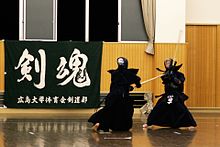
In the long feudal period governed by the samurai class, some methods that were used to train warriors were developed into well-ordered martial arts, in modern times referred to collectively as koryū. Examples include kenjutsu, kendo, kyūdō, sōjutsu, jujutsu, and sumo, all of which were established in the Edo period. After the rapid social change in the Meiji Restoration, some martial arts changed into modern sports, called gendai budō. Judo was developed by Kanō Jigorō, who studied some sects of jujutsu. These sports are still widely practiced in present-day Japan and other countries.
Baseball, Association football, and other popular western sports were imported to Japan in the Meiji period. These sports are commonly practiced in schools, along with traditional martial arts. Baseball, soccer, football, and ping pong are the most popular sports in Japan. Association football gained prominence in Japan after the J League (Japan Professional Football League) was established in 1991. Japan also co-hosted the 2002 FIFA World Cup. In addition, there are many semi-professional organizations, which are sponsored by private companies: for example, volleyball, basketball, rugby union, table tennis, and so on.
Cuisine[]
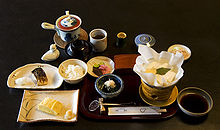
Through a long culinary past, the Japanese have developed sophisticated and refined cuisine. In more recent years, Japanese food has become fashionable and popular in the United States, Europe, and many other areas. Dishes such as sushi, tempura, noodles, and teriyaki are some of the foods that are commonly known. The Japanese diet consists principally of rice; fresh, lean seafood; and pickled or boiled vegetables. The healthy Japanese diet is often believed to be related to the longevity of Japanese people.
Popular culture[]
Japanese popular culture not only reflects the attitudes and concerns of the present day but also provides a link to the past. Popular films, television programs, manga, music, anime and video games all developed from older artistic and literary traditions, and many of their themes and styles of presentation can be traced to traditional art forms. Contemporary forms of popular culture, much like the traditional forms, provide not only entertainment but also an escape for the contemporary Japanese from the problems of an industrial world. Many anime and manga are very popular around the world and continue to become popular, as well as Japanese video games, fashion, and game shows.[27]
In the late 1980s, the family was the focus of leisure activities, such as excursions to parks or shopping districts. Although Japan is often thought of as a hard-working society with little time for leisure, the Japanese seek entertainment wherever they can. It is common to see Japanese commuters riding the train to work, enjoying their favorite manga, or listening through earphones to the latest in popular music. A wide variety of types of popular entertainment are available. There is a large selection of music, films, and the products of a huge manga and anime industry, among other forms of entertainment, from which to choose. Game centers, bowling alleys, and karaoke are popular hangout places for teens while older people may play shogi or go in specialized parlors. Together, the publishing, film/video, music/audio, and game industries in Japan make up the growing Japanese content industry.[28]
Cultural landscapes[]
There are 51 official cultural landscapes (文化的景観, bunkateki keikan) in Japan. These landscapes evolved with the way of life and geocultural features of a region, and which are indispensable for understanding the lifestyle of the Japanese people.[29][30][31][32][33]
The Three Views of Japan (日本三景, Nihon Sankei) is the canonical list of Japan's three most celebrated scenic sights, attributed to 1643 scholar Hayashi Gahō.[34] These are the pine-clad islands of Matsushima in Miyagi Prefecture, the pine-clad sandbar of Amanohashidate in Kyoto Prefecture, and Itsukushima Shrine in Hiroshima Prefecture. In 1915, the New Three Views of Japan were selected with a national election by the Jitsugyo no Nihon Sha (株式会社実業之日本社, Kabushiki Kaisha Jitsugyō no Nihon Sha). In 2003, the Three Major Night Views of Japan were selected by the New Three Major Night Views of Japan and the 100 Night Views of Japan Club (新日本三大夜景・夜景100選事務局).
- Three Views of Japan
Pine-clad islands of Matsushima

Sandbar of Amanohashidate
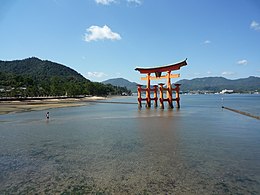
Torii at Itsukushima Shrine
National symbols[]

The Japanese archipelago is located to the east of the Asian continent. Japan is regarded as the most eastern Asian country, because east of Japan is the vast Pacific Ocean. Minamitorishima is Japan's easternmost island. Thus Japan is the land where the sun rises before the Asian continent. The kanji that make up the name of Japan literally mean 'sun origin' (日本). It is pronounced as 'Nihon' or 'Nippon' in Japanese,[35] and is often referred to by the epithet "Land of the Rising Sun".[36] The Nisshōki (日章旗, "sun-rise flag") is the national flag of Japan. It symbolizes the rising sun and corresponds with the name of Japan. The earliest accounts of the rising sun flag is in the 7th century CE. In 607, an official correspondence that began with "from the Emperor of the rising sun" was sent to Chinese Emperor Yang of Sui.[37] Thus the central importance of the sun in Japanese culture is represented in the national flag and other cultural goods. Similarly, the Japan Self-Defense Forces have flags that symbolize the sun.
The Sun also plays an important role in Japanese mythology and religion as the emperor is said to be the direct descendant of the Sun goddess Amaterasu, the personification of Japan. She is seen as the goddess of the Sun and the universe in Shinto religion. The emperor is "the symbol of the State and of the unity of the people." Emperor Jimmu (神武天皇, Jinmu-tennō) is the national founder of Japan.
The national animals are the green pheasant, koi fish and the great purple emperor butterfly. The Imperial Seal of Japan is one of the national seals and a crest (mon) used by the Emperor of Japan and members of the Imperial Family. The cherry blossom (Prunus serrulata) & chrysanthemum morifolium are de facto national flowers of Japan. Japan's de facto national dish is sushi,[38] Japanese curry[39] and ramen.[40] The de facto national liquor is sake.[41]
Mount Fuji (富士山, Fujisan) is the national mountain of Japan. It is one of Japan's "Three Holy Mountains" (三霊山, Sanreizan) along with Mount Tate and Mount Haku. It is also a Special Place of Scenic Beauty and one of Japan's Historic Sites.[42] The summit is considered a sacred place since ancient times. As a national symbol of the country, Mount Fuji has been depicted in various art and media such as painting, woodblock prints (such as the Thirty-six Views of Mount Fuji), poetry, music, theater, film, manga, anime and pottery.[43]
Gallery[]

Left panel of the Shōrin-zu byōbu, by Hasegawa Tohaku, c. 1595, six-fold screen, ink on paper, National Treasure

Fūjin-raijin-zu by Tawaraya Sōtatsu, with Raijin shown on the left and Fūjin right, 17th century

Kakiemon Imari ware hexagonal jar, flowering plant and phoenix design in overglaze enamel.

Kamidana (home shrine) with kagamimochi and ofuda

Daruma of various sizes

Hamaya at Ikuta Shrine
Japanese foldable fan of late Heian period (12th century)

Traditional Japanese ceremony at Itsukushima Shrine
rock garden in Iwakura (Kyoto), reformed in 2013.

Lolita fashion is a fashion subculture that is highly influenced by Victorian and Edwardian from the Rococo period.
See also[]
- Cool Japan
- History of Japan
- National symbols of Japan
- Imperial House of Japan
- Tourism in Japan
- Japanese castle
- Japanese architecture
- Historic Monuments of Ancient Kyoto
- List of World Heritage Sites in Japan
- National Treasure (Japan)
- List of museums in Japan
- List of mountains and hills of Japan by height
- Mount Fuji
- Onsen
- Japanese Language
- Hiragana
- Katakana
- Kanji
- Emoji
- Japanese honorifics
- Wasei-kango
- Etiquette in Japan
- Religion in Japan
- Shinto
- Kami
- Japanese mythology
- Japanese festivals
- Buddhism
- Zen
- Japanese new religions
- Onmyodo
- Japanese cuisine
- Japanese Aesthetics
- Japanese art
- Wabi-sabi
- Manga
- Anime
- Ukiyo-e
- Bonsai
- Ikebana
- Origami
- Mon (emblem)
- Japanese music
- J-Pop
- Enka
- Japanese idol
- Japanese metal
- Japanese rock
- Para Para
- Japanese performing arts
- Science and technology in Japan
- Shinkansen
- Japanese sword
- Japanese automotive industry
- Electronics industry in Japan
- Video games developed in Japan
- Japan Aerospace Exploration Agency
- Japanese martial arts
- Judo
- Karate
- Sumo
- Kendo
- Ninjutsu
- Aikido
- Yamato damashii
- Samurai
- Bushido
- Ninja
- Kamikaze
- Bonsai
- Seppuku
- Japan Self-Defense Forces
- Racial Equality Proposal
References[]
- Cwiertka, Katarzyna J. (2007). Modern Japanese Cuisine: Food, Power and National Identity. Reaktion Books. ISBN 978-1-86189-298-0. Review
- Japan
 This article incorporates public domain material from the Library of Congress Country Studies website http://lcweb2.loc.gov/frd/cs/.
This article incorporates public domain material from the Library of Congress Country Studies website http://lcweb2.loc.gov/frd/cs/. - Goldstein-Gidoni, Ofra (Fall 1999). "Kimono And The Construction of Gendered and Cultural Identities". Ethnology. 38 (4): 351–370. doi:10.2307/3773912. JSTOR 3773912.
- Martin, Richard (1995). "Our Kimono Mind: Reflections on 'Japanese Design: A Survey since 1950'". Journal of Design History. 8 (3): 215–223. doi:10.1093/jdh/8.3.215.
- Nakagawa, Keiichirō; Rosovsky, Henry (Spring–Summer 1963). "The Case of the Dying Kimono: The Influence of Changing Fashions on the Development of the Japanese Woolen Industry". The Business History Review. 37 (1/2): 59–80. doi:10.2307/3112093. JSTOR 3112093.
- Dyer, Henry (1909). Japan in World Politics: A Study in International Dynamics. Blackie & Son Limited.
- Varley, Paul. Japanese Culture. 4th Edition. Honolulu. 2000.
- Nippon The Land And Its People. 2006.
Notes[]
- ^ Haffner, John; Klett, Tomas; Lehmann, Jean-Pierre (2009). Japan's Open Future: An Agenda for Global Citizenship. Anthem Press. p. 17. ISBN 978-1843313113.
- ^ Seiji Kobayashi. "Eastern Japanese Pottery During the Jomon-Yayoi Transition: A Study in Forager-Farmer Interaction". Kokugakuin Tochigi Junior College. Archived from the original on 23 September 2009.
- ^ Kanzawa-Kiriyama, H.; Kryukov, K.; Jinam, T. A.; Hosomichi, K.; Saso, A.; Suwa, G.; Ueda, S.; Yoneda, M.; Tajima, A.; Shinoda, K. I.; Inoue, I.; Saitou, N. (1 June 2016). "A partial nuclear genome of the Jomons who lived 3000 years ago in Fukushima, Japan". Journal of Human Genetics. 62 (2): 213–221. doi:10.1038/jhg.2016.110. PMC 5285490. PMID 27581845.
- ^ Jump up to: a b Deal, William E. (2005). Handbook to Life in Medieval and Early Modern Japan. Infobase Publishing. p. 242. ISBN 978-0-8160-7485-3.
Japanese has no genetic affiliation with Chinese, but neither does it have any clear affiliation with any other language.
- ^ "How Japan became a pop culture superpower". The Spectator. 31 January 2015.
- ^ Tamaki, Taku. "Japan has turned its culture into a powerful political tool". The Conversation.
- ^ "Janan's Culture". USnews. 2021. Retrieved 24 May 2021.
- ^ Yookoso! An Invitation to Contemporary Japanese 1st edition McGraw-Hill, page 13 "Linguistic Note: The Origins of Hiragana and Katakana"
- ^ Burlock, Ben (2017). "How did katakana and hiragana originate?". sci.lang.japan. Retrieved 26 July 2017.
- ^ Ager, Simon (2017). "Japanese Hiragana". Omniglot. Retrieved 26 July 2017.
- ^ Jump up to: a b 宗教年鑑 令和元年版 [Religious Yearbook 2019] (PDF) (in Japanese). Agency for Cultural Affairs, Government of Japan. 2019. p. 35.
- ^ Yasunori, Kawakami; JapanFocus.org (30 May 2007). "Local Mosques and the Lives of Muslims in Japan". JapanFocus.org. Retrieved 27 December 2008.
- ^ Jump up to: a b Watt, Paul (October 2003). "Japanese Religions". FSI | SPICE. Retrieved 28 September 2017.
- ^ Peter N. Dale, The Myth of Japanese Uniqueness (London: Routledge, 1990; ISBN 0-415-05534-2), passim.
- ^ Bowie, Henry P. (1952). On the Laws of Japanese Painting. Dover Publications, Inc. pp. 4, 16–19.
- ^ "Namban & Enconchado: Japan and Mexico Meet". japan-and-mexico-meet.tumblr.com. Retrieved 19 January 2021.
- ^ Urushi once attracted the world urushi-joboji.com
- ^ Jump up to: a b Dalby, Liza (2001). Kimono: Fashioning Culture. Seattle: University of Washington Press. ISBN 9780295981550. OCLC 46793052.
- ^ Kuitert, Wybe (1988). Themes, Scenes, and Taste in the History of Japanese Garden Art. J.C.Gieben, Publisher, Amsterdam. ISBN 978-90-5063-021-4.
- ^ Kenkyusha's New Japanese-English Dictionary, ISBN 4-7674-2015-6
- ^ "America's Top Pop Imports". Forbes. 26 February 2008. Archived from the original on 3 March 2008. Retrieved 23 September 2010.
- ^ "2014 Oricon Yearly Album Ranking TOP50". tokyohive. 6Theory Media, LLC. 20 December 2014. Archived from the original on 25 June 2015. Retrieved 22 April 2015.
- ^ Jump up to: a b Web, Japan. "Japan Fact Sheet" (PDF). Noh and Kyogen: The world's oldest living theater. Archived from the original (PDF) on 9 April 2008. Retrieved 1 March 2008.
- ^ Jump up to: a b Web, Japan. "Japan Fact Sheet" (PDF). Kabuki: A vibrant and exciting traditional theater. Archived from the original (PDF) on 9 April 2008. Retrieved 1 March 2008.
- ^ Web, Japan. "Japan Fact Sheet" (PDF). Bunraku: Puppet theater brings old Japan to life. Archived from the original (PDF) on 9 April 2008. Retrieved 1 March 2008.
- ^ "Takarazuka History". Takarazuka Revue. Archived from the original on 25 February 2008. Retrieved 1 March 2008.
- ^ "Cool Japan: Why Japanese remakes are so popular on American TV, and where we're getting it wrong" Archived 15 September 2008 at the Wayback Machine. AsianWeek. Retrieved on 2008-09-16.
- ^ "Digital Content Association Of Japan". Dcaj.org. 27 January 2012. Archived from the original on 6 January 2012. Retrieved 2 February 2012.
- ^ "Our Treasure Cultural Landscapes to future generations" (PDF). Administration of Cultural Affairs in Japan ― Fiscal 2009. Agency for Cultural Affairs. 2009. Archived from the original (PDF) on 26 October 2010. Retrieved 3 January 2010.
- ^ The Agency for Cultural Affairs (1 November 2008). 国指定文化財 データベース (in Japanese). Database of National Cultural Properties. Retrieved 16 April 2009.
- ^ "Policy of Cultural Affairs in Japan" (PDF). Agency for Cultural Affairs. 2015. Archived from the original (PDF) on 27 April 2016.
- ^ "文化的景観" [Cultural Landscapes] (in Japanese). Agency for Cultural Affairs. 2015.
- ^ "重要文化的景観選定地一覧" [Important Cultural Landscapes Sites] (in Japanese). Nara National Research Institute for Cultural Properties. 2015.
- ^ "Amanohashidate – History". Amanohashidate kankokyokai. Archived from the original on 17 July 2011. Retrieved 14 May 2011.
- ^ "Where does the name Japan come from?". Retrieved 29 January 2017.
- ^ Piggott, Joan R. (1997). The emergence of Japanese kingship. Stanford University Press. pp. 143–144. ISBN 978-0-8047-2832-4.
- ^ Dyer 1909, p. 24
- ^ "Traditional Dishes of Japan". Japan National Tourism Organization. Retrieved 24 June 2014.
- ^ 『カレーライス』に関するアンケート (in Japanese). ネットリサーチ ディムスドライブ. Retrieved 16 October 2008.
- ^ McCurry, Justin (18 June 2010). "Ramen: Japan's super slurpy noodles". The Guardian. London. Retrieved 5 June 2011.
- ^ RatesToGo: Best National Drinks Part I Archived 2009-11-02 at the Wayback Machine
- ^ [1] Archived June 27, 2013, at the Wayback Machine
- ^ "収蔵品のご紹介 | サンリツ服部美術館". www.sunritz-hattori-museum.or.jp.
Further reading[]
- Japan Unbound: A Volatile Nation's Quest for Pride and Purpose
- The Chrysanthemum and the Sword
- Momoyama, Japanese art in the age of grandeur. New York: The Metropolitan Museum of Art. 1975. ISBN 9780870991257.
- Kamei, Shunsuke (June 1981). "The Kiss and Japanese Culture after World War II". Comparative Literature Studies. 18 (2): 114–123. ISSN 0010-4132. JSTOR 40246247.
External links[]
| Wikimedia Commons has media related to Culture of Japan. |
- Japanese-City.com Japanese Cultural Events by Japanese Organizations throughout America.
- The History of Japanese Calligraphy In English, at BeyondCalligraphy.com
- Japan Society – New York City North America's single major producer of high-quality content on Japan for an English-speaking audience.
- Agency for Cultural Affairs
- Traditional Culture – The Imperial Household Agency
- "Working with the Japanese," BBC
- Rare Materials Exhibition – Kyoto University Digital Library(貴重資料画像--京都大学電子図書館) Image files of rare materials related to culture of Japan
- Japanese Architecture and Art Net Users System
- Web Japan
- Japanese culture





















